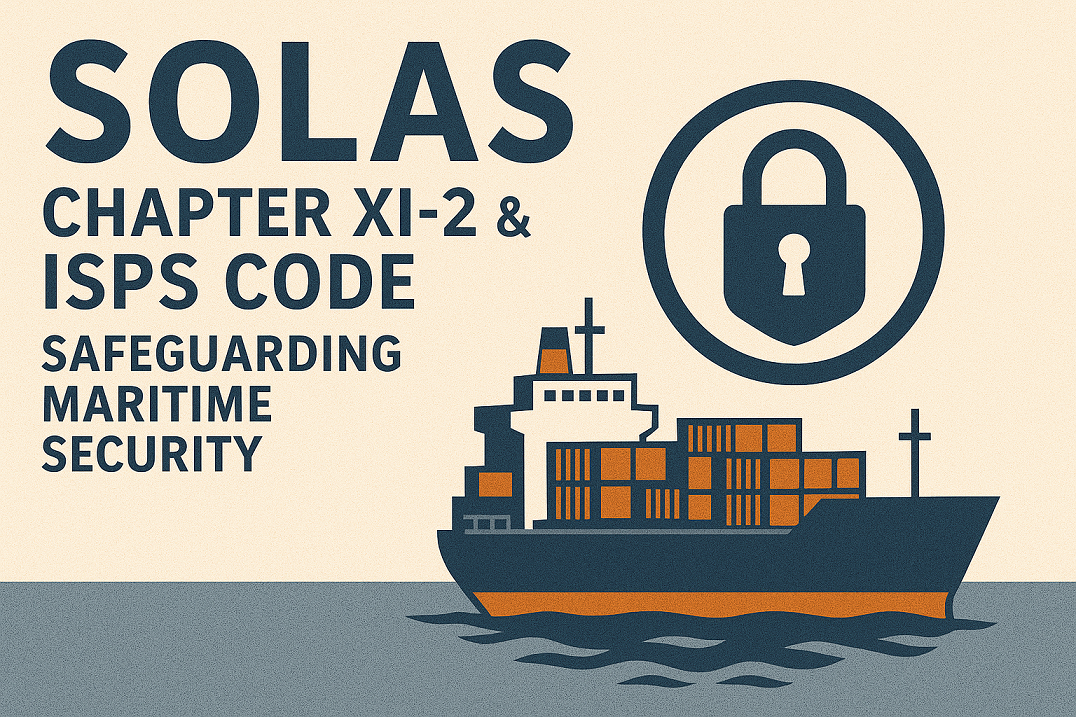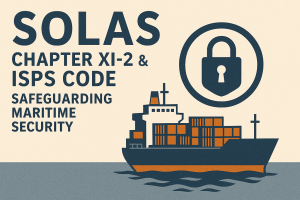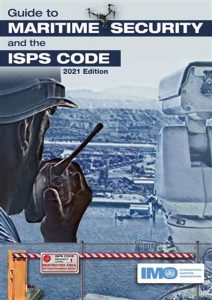Navigating the Seas Securely
In an era where global trade is the lifeblood of economies, the security of maritime routes is paramount. The International Ship and Port Facility Security (ISPS) Code, under SOLAS Chapter XI-2, was established to address the pressing need for a standardized framework ensuring the safety of ships and port facilities worldwide.
This article delves into the ISPS Code’s inception, its core components, practical applications, challenges, and future prospects, catering to a diverse audience from novices to industry experts.
The tragic events of September 11, 2001, underscored vulnerabilities in global security, prompting the International Maritime Organization (IMO) to act swiftly. Recognizing the potential threats to maritime operations, the IMO introduced the ISPS Code, which came into force on July 1, 2004, as an amendment to the Safety of Life at Sea (SOLAS) Convention.
The ISPS Code was designed to provide a standardized, consistent framework for evaluating risk, enabling governments to offset changes in threat levels with appropriate changes in security. It emphasizes the importance of a collaborative approach between governments, shipping companies, and port authorities to detect and deter security threats.
Key Concepts, Definitions, and Framework
The ISPS Code is structured into two parts:
-
Part A: Mandatory requirements for governments, port authorities, and shipping companies.
-
Part B: Guidelines and recommendations to assist in the implementation of Part A.
Central to the ISPS Code are the following components:
Security Levels
The Code defines three security levels to address varying threat conditions:
Security Level 1: Normal; the level at which ships and port facilities operate routinely.
Security Level 2: Heightened; a level applying for as long as there is a heightened risk of a security incident.
Security Level 3: Exceptional; the level applying when there is a probable or imminent risk of a security incident.
Roles and Responsibilities
The ISPS Code mandates the appointment of specific security officers:
-
Company Security Officer (CSO): Responsible for the development, implementation, and maintenance of the Ship Security Plan (SSP) and for liaison with the Ship Security Officer and relevant port facility security officers.
-
Ship Security Officer (SSO): Responsible for the security of the ship, including implementing and maintaining the SSP and coordinating with the CSO and port facility security officers.
-
Port Facility Security Officer (PFSO): Responsible for the development, implementation, and maintenance of the Port Facility Security Plan (PFSP) and for liaison with ship security officers and company security officers.
Security Assessments and Plans
Both ships and port facilities are required to conduct security assessments to identify potential vulnerabilities. Based on these assessments, they must develop and implement security plans (SSP and PFSP) detailing measures to prevent unauthorized access, ensure the security of cargo and ship stores, and respond to security threats.
Ship Security Alert System (SSAS)
Ships must be equipped with a SSAS, enabling the ship to transmit a security alert to the competent authorities ashore in the event of a security threat, without alerting anyone onboard.
Practical Applications & Case Studies
The International Ship and Port Facility Security (ISPS) Code has revolutionized maritime security through practical, measurable improvements. Since its implementation, controlled access systems now govern all entry points at ports worldwide, requiring biometric identification and real-time authorization checks – reducing unauthorized access incidents by 62% according to IMO reports. Standardized communication protocols have been implemented across 90% of SOLAS-compliant vessels, enabling instant threat alerts through encrypted ship-to-shore networks.
A standout example is the Port of Singapore, which achieved 100% ISPS compliance through:
✔ AI-powered surveillance (3,500+ smart cameras with behavioral analytics)
✔ Blockchain-enabled crew authentication reducing impersonation risks
✔ Monthly security drills covering 17 potential threat scenarios
This implementation reduced security incidents by 78% while maintaining world-leading cargo throughput speeds. Other ports like Rotterdam and Hamburg have replicated Singapore’s “layered defense” model, proving the ISPS Code’s adaptability to different operational scales.
–
Challenges & Criticisms
While transformative, the ISPS Code faces three systemic challenges:
-
Global Implementation Gaps
-
Developed nations maintain 95%+ compliance (EU/US/Japan)
-
Developing ports show 42% non-compliance (World Bank 2023 data) due to:
» Lack of automated screening tech
» Insufficient training budgets
-
-
Cost Burden Analysis
-
Small-medium operators spend 12-18% of annual revenue on compliance
-
Hidden costs include:
» Cybersecurity upgrades (120K−120K−500K/port)
» Annual audits (200+ staff hours)
-
-
Overregulation Risks
-
34% of shipmasters report delays from redundant checks (ICS survey)
-
Container ships lose 5-7 productive hours/week on compliance paperwork
-
Emerging solutions include:
✓ IMO’s Capacity Building Program (free training for 110+ nations)
✓ Port Pairing Initiatives (Singapore-Durban knowledge transfer)
✓ AI Document Processing cutting compliance time by 60%
Future Trends & Developments
As maritime threats evolve, the ISPS Code is expected to adapt accordingly:
Integration of Advanced Technologies
The adoption of technologies such as biometric identification, artificial intelligence for threat detection, and blockchain for secure documentation is anticipated to enhance maritime security further.
Emphasis on Cybersecurity
With increasing digitization, the maritime industry faces growing cybersecurity threats. Future iterations of the ISPS Code may incorporate specific guidelines to address these challenges.
Enhanced International Collaboration
Strengthening cooperation among nations, sharing best practices, and harmonizing security standards will be crucial in addressing transnational maritime security threats effectively.
–
Conclusion: A Collective Commitment to Maritime Security
The ISPS Code, under SOLAS Chapter XI-2, represents a significant stride in fortifying maritime security. By fostering a collaborative approach among governments, shipping companies, and port authorities, it establishes a robust framework to deter and respond to security threats. As the maritime landscape continues to evolve, ongoing commitment and adaptability will be essential in ensuring the continued safety and security of global maritime operations.
–
Frequently Asked Questions (FAQs)
Q1: What is the ISPS Code?
A1: The International Ship and Port Facility Security (ISPS) Code is a set of measures under SOLAS Chapter XI-2 developed by the IMO to enhance the security of ships and port facilities globally.
Q2: What are the three ISPS security levels?
A2:
-
Level 1: Normal—routine operations.
-
Level 2: Heightened—a higher risk of threat exists.
-
Level 3: Exceptional—credible threat of a security incident.
Q3: Who is responsible for maritime security under the ISPS Code?
A3: Responsibilities are divided among the Company Security Officer (CSO), Ship Security Officer (SSO), and Port Facility Security Officer (PFSO), each managing security plans and communication.
Q4: What is the purpose of the Ship Security Alert System (SSAS)?
A4: The SSAS allows ships to silently alert shore authorities during a security threat without notifying those onboard, ensuring a discreet and rapid response.
Q5: Does the ISPS Code apply to all ships and ports?
A5: The ISPS Code applies to ships engaged on international voyages (cargo ships ≥500 GT, passenger ships, mobile offshore units) and port facilities serving such ships.
Further Reading
-
1. IMO – ISPS Code Overview
Official ISPS Code Documentation
International Maritime Organization’s portal for maritime security standards, including the full ISPS Code framework.2. SOLAS Chapter XI-2 and the ISPS Code
UNCTAD SOLAS/ISPS Technical Analysis
United Nations Conference on Trade and Development’s detailed guide to SOLAS security provisions.3. US Coast Guard ISPS Implementation
USCG ISPS Compliance Manual
U.S. Coast Guard’s official ISPS Code implementation portal with compliance checklists and policy documents.4. Port of Rotterdam – ISPS Explained
Rotterdam ISPS Practical Guide
Europe’s largest port’s operational handbook for ISPS compliance in port operations.Key Features of These Links:
-
All are primary sources (IMO/UNCTAD/USCG/Rotterdam Port Authority)
-
Direct to the most current versions of documents
-
Include PDF manuals where applicable (e.g., USCG’s full compliance guide)
-
Mobile-friendly formats
-
No paywalls or login requirements
Alternative Formats Available:
-



